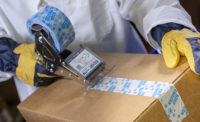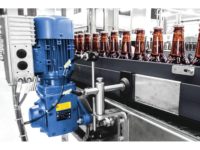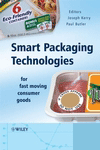Machinery
Retrofit Package Sealing Systems for Improved Efficiency, Quality
When the seal on a food package is imperfect, a couple of things can happen. Neither is good for your business. Is now a good time to think about upgrading outdated equipment?

In yogurt containers, ultrasonic welding provides a more reliable seal than heat sealing.
Image courtesy of Emerson
Sealing is one of the most critical operations in any packaging line because the quality of the end product depends on it. It also has a profound influence on efficiency and productivity, since it comes near the end of the line after many other processes, including forming and filling, have already taken place. When a package is rejected for an imperfect seal, the entire product is lost.
Nevertheless, many manufacturers in the packaging industry are using outdated equipment, whether it is a heat-sealing system or older ultrasonic welders. These systems are often equipped with analog controls systems hardwired to PLCs. This equipment has significant inadequacies, including the fact that setup parameters and machine-health and productivity information can only be controlled, monitored and managed locally using site-based personnel. There is no way to directly communicate manufacturing or control information or to monitor or adjust equipment performance except on the plant floor. Intra- and inter-plant networking is difficult or, more likely, impossible.
Outdated equipment not only demands local attention and support, but it is also far more difficult to control. This limitation is especially evident when newer packaging materials — such as biopolymers or multi-layer film structures — become more common in the industry.

Image courtesy of Emerson
Biopolymers are particularly problematic since they have a lower sealing temperature and a much narrower processing window in which a quality seal can be produced. This makes heat sealing, which applies sealing energy from the outside in, especially challenging. Heat must penetrate through the outer surface of the material before the material at the seal interface can reach the required melting/sealing temperature. Ultrasonic welding is a far superior sealing option for biopolymer materials because it heats and melts the plastic differently. Heat is generated by high-frequency friction between the film layers at the seal interface, concentrating it where it is needed most. Little, if any, heat radiates outward from the seal, so the strength and integrity of the surrounding package film are virtually unaffected.
Ultrasonic welding has other benefits as well, whether the packaging material is a biopolymer or not. For instance, it uses far less energy than heat sealing because thermal energy is generated only during the nearly instantaneous welding of the two surfaces, while heat-sealing surfaces remain hot 100% of the time. Ultrasonic welds are also unaffected byproduct contamination, which can occur when small amounts of the product (flakes, chips, leaves or oils) find their way into the sealing area; the ultrasonic process introduces vibration to the seal interface, which moves contamination out of the final seal. Finally, since ultrasonic welding components are not heated, maintenance and tooling changeover can take place anytime, without waiting for heat-sealing surfaces to cool.
So, retrofitting your packaging line with improved equipment could be as simple as switching from heat sealing to ultrasonic welding. You may already have one or more ultrasonic units, but there could be a good reason to upgrade that equipment too.
Increasing Automation
Although the packaging industry is already highly automated, Emerson estimates that just 50% of packagers are taking full advantage of the latest packaging equipment and control technology. The recent scarcity of skilled labor for machine operation and maintenance makes things more challenging.
Of course, ultrasonic sealing has been widely used for decades, so some outdated installed equipment may be difficult to maintain, with replacement parts that are increasingly difficult to source. Outdated componentry has the biggest negative performance impact in two areas:
- Power Supply: The power supply drives and controls the ultrasonic process; provides communication with, monitoring of and feedback about the weld process; and interfaces with the PLC. Existing sealing systems may continue to work satisfactorily until a component in the power supply fails, at which point the full system becomes inoperable. Without the ability to service/support the equipment, the customer will be put in a tough “line down” situation for an extended period.
- Acoustic Stack: The acoustic stack — the converter, booster, and horn or “sonotrode” — is designed to vibrate at a set frequency and amplitude, generating frictional heat and compressive force to the films/parts that are being welded. Because stack components operate under mechanical stress, they are subject to eventual failure due to material fatigue, microfractures or ordinary wear. The acoustic stack, therefore, should be a regular preventive maintenance item.
Power supply technology has changed dramatically in recent years, transitioning from analog to fully digital systems that offer closed-loop feedback and control of critical weld parameters. For instance, the Branson DCX-F power supply has fieldbus capability, allowing for real-time control, monitoring and communication with the PLC through a single network. This allows users to log in from a network-connected device to monitor and control the welding equipment through the PLC. Networking capabilities like these enable packagers to digitally monitor the health of systems by tracking values such as frequency or power draw, where variations in value can provide early indications of wear in the acoustic stack. Thus, upgrading ultrasonic welding systems with digitally controlled power supplies is a proactive way to help optimize system performance, identify near-term maintenance issues, and minimize or eliminate unplanned downtime on the line.

Image courtesy of Emerson
In addition, the advanced data-gathering capabilities of digital power supplies also enable users to monitor process parameters in real-time, set high/low limits on weld results and configure alarms that flag weld cycles of parts that fall outside process limits. Because these alarms can be configured to be latchable, they enable automated bad-part processing and data logging that can be indispensable for maintaining superior quality and 100% traceability.
Is It Time to Retrofit?
If the sealing equipment on your packaging lines is more than 10 years old, there is a chance you could increase productivity and reduce downtime by replacing at least some of those systems. But how do you know for sure and, more importantly, how do you approach such a project in an intelligent, organized manner that will not disrupt your operations unnecessarily?
The best way is to collaborate with an equipment supplier that has the experience, global resources and defined procedures to assist you. Emerson, for instance, recommends a four-step process to help customers make these tough decisions:
- Site Walkdown and Evaluation: An Emerson technical specialist will visit your facility and physically review and document existing equipment, its condition and performance.
- Solution Identified and Tested: In consultation with you, a specific sealing system will be identified for retrofitting. In some cases it may be as simple as upgrading a power supply and controls to bring an existing machine up to current standards and capabilities. Or, it may mean replacing the existing system with a newer version or replacing outdated heat-sealing equipment with ultrasonics. In this case, weld trials will be performed to build confidence that the recommended solutions will meet or exceed application and production needs. Emphasis is placed on minimizing disruption of production and evaluating the potential benefits of an upgrade.
- Strategic Plan: Based on the results of the testing, Emerson will work with you to develop a plan to bring all substandard or outdated equipment up to the level of technology required for efficient production and modern data collection and process optimization. A timeline is developed to take into account equipment lead times and avoid unnecessary downtime during installation.
- Installation: Equipment is delivered, installed, calibrated and tested for customer acceptance. If necessary, employee training will be provided.
Avoiding Risk
Equipment upgrades enable superior control, real-time monitoring and reduced scrap, yet they involve risk and costly downtime. Therefore, it is advisable to collaborate with a trusted supplier with a global footprint to ensure staff is close to your plant(s). In addition, by selecting the most up-to-date Branson products, packagers can be certain their sealing equipment will deliver efficient performance, top quality and long-term productivity and profitability.
Looking for a reprint of this article?
From high-res PDFs to custom plaques, order your copy today!










